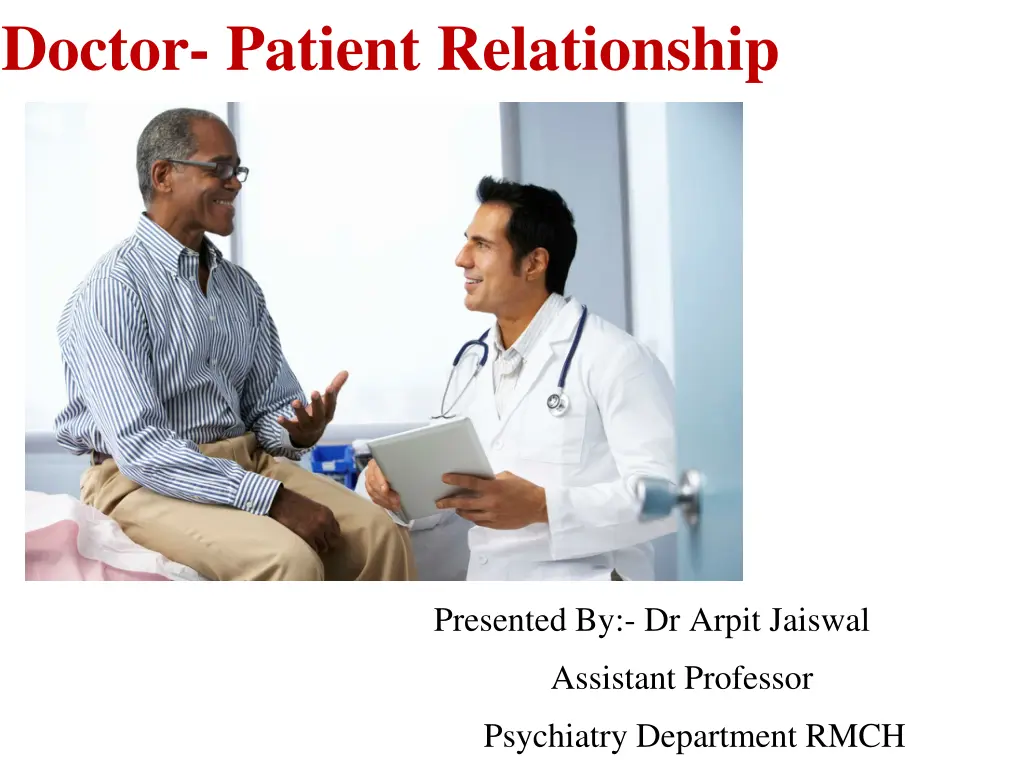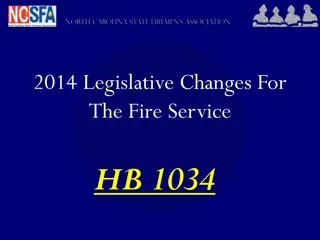
Understanding Doctor-Patient Relationship Dynamics
Explore the significance of the doctor-patient relationship in healthcare, including sociological perspectives, role conflicts, outcomes, and different relationship types such as paternalistic and mutual. Learn how this relationship influences treatment success and patient satisfaction.
Download Presentation

Please find below an Image/Link to download the presentation.
The content on the website is provided AS IS for your information and personal use only. It may not be sold, licensed, or shared on other websites without obtaining consent from the author. If you encounter any issues during the download, it is possible that the publisher has removed the file from their server.
You are allowed to download the files provided on this website for personal or commercial use, subject to the condition that they are used lawfully. All files are the property of their respective owners.
The content on the website is provided AS IS for your information and personal use only. It may not be sold, licensed, or shared on other websites without obtaining consent from the author.
E N D
Presentation Transcript
Doctor- Patient Relationship Presented By:- Dr Arpit Jaiswal Assistant Professor Psychiatry Department RMCH
Doctor Patient relationship The nature of the relationship determines the success of the treatment/intervention PARSONS was one of the earliest sociologist to examine doctor patient relationship He regarded illness as a form of social deviance (impairs normal role performance, affects smooth functioning of the society) The amount of illness is controlled by socially prescribed roles for doctors & patients 2
Parsons Social roles of doctors & patients 3
Other models Szasz & hollender Seriously ill patient activity passivity model Acute ( infectious diseases) guidance cooperation model Chronic diseases mutual participation model 4
Conflicts in doctors role Doctors patients homosexuality) Interest of the patient vs. state (sick note, notification) Interest of individual patients vs. wider (rationing of resources) Confidentiality own (abortion, values vs. AIDS, population 5
Outcomes Clinical Satisfaction Doctor Failure to elicit patients worries & interpretation of symptoms lead to believe that patients have consulted inappropriately & their time & skills are wasted Patient Perception of the doctors interpersonal & clinical skills Patients satisfaction with the initial consultation Information & advice given 6
Types of doctor patient relationship Paternalistic If I ve told you once I told you 1,000 times, stop smoking!! The traditional D-P relationship Doctor Takes on role of parent Patient submissive Shift towards Mutuality 8
Types of doctor patient relationship Mutuality Equal partners Meeting between experts Joint venture Exchange of ideas 9
Types of doctor patient relationship Consumerist Doctor: passive You re paid to do what I tell you!! Patient : active role Second opinion, referral to hospital, sick note 10
Types of doctor patient relationship Default Patient adopts a passive role Doctor reduces his control If patient is not aware of alternatives to passive patient role/ timid in adopting a participative relationship 11
Influences on doctor patient relationship - Consultation style Doctor centered Paternalistic - doctor is the expert and patient expected to cooperate Tightly controlled interviewing style aimed at reaching an organic diagnosis. Closed questions voice of medicine - focus on biomedical diagnosis and treatment as quickly as possible 12
Influences on doctor patient relationship - Consultation style Patient centered Mutuality Less authoritarian - encourages patient to their own feelings and concerns Open questioning, interested in psycho-social aspect of illness Voice of the patient- communication of patients beliefs feelings & psychosocial context (bio psychosocial) 13
Influences on doctor patient relationship - Time Average 6 minutes Pressures of time- doctor centered consultation However, doctors own style & approach influences than the time available Patient centric approach needs more time but overall reduces the number of return visits & thus the total consultation time 14
Influences on doctor patient relationship - Patient The patient s ability to exercise and control depends on a number of factors: Age Social and educational level Sex Different languages Membership of an ethnic minority 15
Influences on doctor patient relationship structural context General practice Hospital situation Ward 16
Shared decision making -impetus Increased medical knowledge among patients Prevailing social values- individual autonomy, responsibility Chronic illness To make choices and to balance risks & benefits Doctors make inaccurate guesses about patients concerns & their preferences and treatment choices differ 18
Shared decision making impetus Compliance It is the extent to which a patient follows the instructions of the physician. Research confirms that the doctor-patient relationship is the best predictor of whether the patient will follow the doctor s instructions and advice. Examples of compliance include: Taking medications on schedule. Keeping appointments. Following directions for changes in behavior or diet. Approximately 1/3 of patients are compliant with treatment. 1/3 complies some of the time; and 1/3 don't comply with treatment at all. clinical 19
Shared decision making impetus Compliance Factors associated with decreased patient's compliance: Perception of the physician as rejecting and unfriendly. Physician failure to explain the diagnosis or causes of symptoms. Increased complexity of treatment regimen i.e. more than three types of medication taken more than four times a day Increased number of required behavioral changes. Verbal instructions for taking medication. Visual problems reading prescription labels (particularly in the elderly). 20
Shared decision making impetus Compliance Factors associated with increased patient's compliance Good doctor-patient relationship. Written instructions for taking medication. Patient's subjective feelings of distress or illness. Doctor's awareness of and sensitivity to the patient's belief system. Physician enthusiasm, permissiveness, time spent talking with the patient. Physician experience and older physician age. Short waiting room time. Patient knowledge of the expected positive treatment outcome. Patient knowledge of the names and effects of prescribed drugs. 21
Communication skills Patients communication arise from Content skills what doctors say, e.g., the substance of the questions asked, the answers received, the information given, the differential diagnosis list, and the doctors medical knowledge base Process skills how doctors say it, e.g., how the doctor asks questions, how well he perception of inadequacies of listens, how he sets up explanation planning with the patient, how he structures his interaction and makes that structure visible to the patient through signposting or transitions &how he build relationships with patients and 22
Communication and Treatment Advice, reassurance and support from the doctor can have a significant effect on recovery The placebo effect 24
Thank you We have not lost faith, but we have transferred it from God to the medical profession. - George Bernard Shaw



